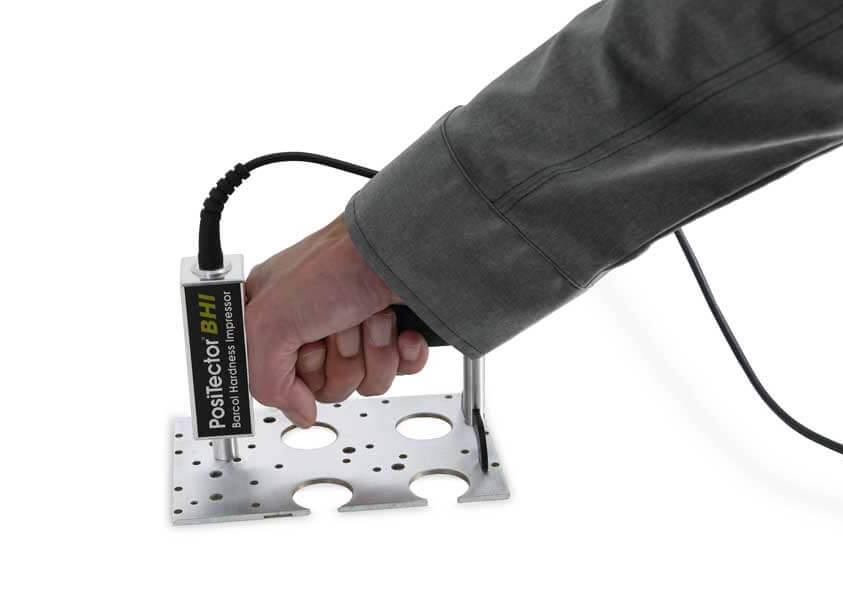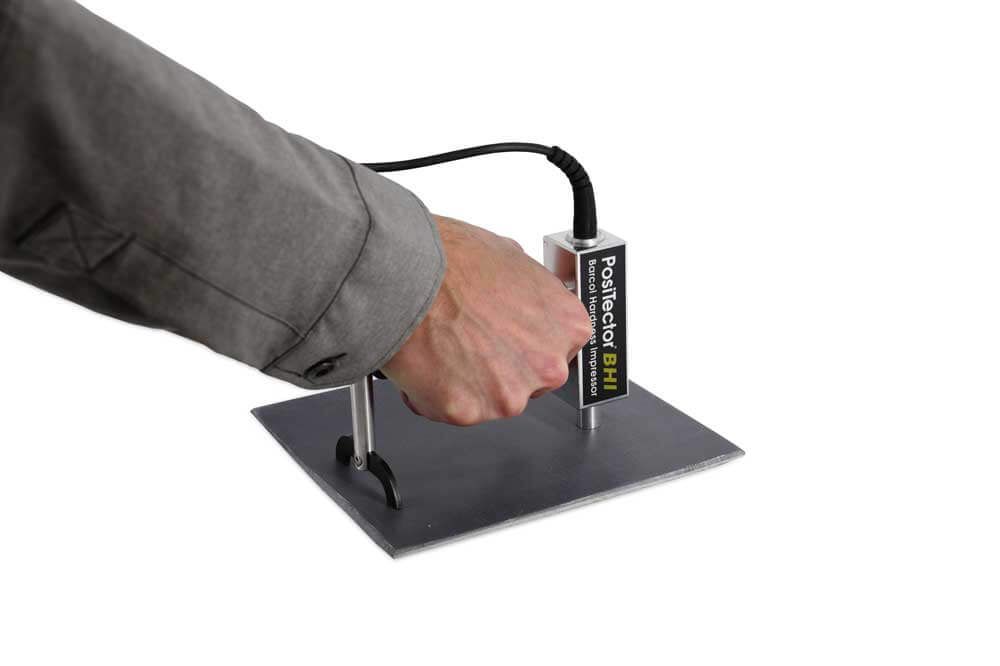Measure Barcol hardness with PosiTector BHI Barcol hardness tester

In this article we explain how the Barcol hardness measurement works with the PosiTector BHI (Barcol Hardness Impressor) Barcol hardness meter.
The Barcol PosiTector BHI hardness tester is designed to test the hardness of hard plastics and soft metals such as aluminium, aluminum alloys, copper and brass. Comparable to the 934-1 Barcol hardness tester, the PosiTector BHI features an easy-to-read digital display, onboard memory and a user-settable measurement timer with on-screen countdown.
Background
The Barcol hardness test has been used to measure the hardness of materials for almost 80 years. The Barcol hardness tester was developed during World War II to ensure that aircraft rivets were not sabotaged by the use of inferior metal. It is still used today for a variety of applications, e.g. B. in aluminum production, fiber and glass fiber reinforced plastics, duroplastics or hard thermoplastics and for measuring the degree of curing of composite materials.
What is material hardness?
Hardness is a measure of a material's ability to resist permanent deformation such as bending, scratching, abrasion or cutting. Quality assurance and control requirements demand that every material meet a specific hardness standard - often determined by tests such as those performed with a Barcol hardness tester. Indentation hardness testers such as the PosiTector BHI and PosiTector SHD use a precisely formed tip (indenter) connected to a calibrated spring. You measure how far the tip penetrates the material. The greater the penetration depth, the lower the hardness.

PosiTector BHI Barcol hardness tester measuring on aluminium

PosiTector BHI Barcol hardness tester measuring fiber reinforced plastic
Why is Barcol hardness measured?
Barcol hardness testing is a critical step in quality assurance and quality control of materials such as rigid plastics, aluminium, aluminum alloys, copper and brass. Each material must meet a specific strength standard. Testing a material's Barcol hardness determines its ability to resist deformation.
For some plastics and fiber reinforced polymer composites, Barcol hardness testers can also be used to measure the degree of cure and crosslinking. The hardness increases as the curing progresses until a maximum value for the respective type of plastic is reached.
What is a Barcol hardness tester?
Barcol hardness is measured with a handheld device such as the PosiTector BHI, which consists of a PosiTector Standard or Advanced Gauge and a probe (here: the PosiTector BHI Barcol Hardness Impressor / indenter). According to ASTM B648, "The indenter shall be a hardened steel truncated cone with an angle of 26° and a flat apex...". One unit of Barcol hardness corresponds to 0.0076 mm (0.00030 inches) of indenter movement. A value of zero means the indenter has penetrated the full 0.76mm into the surface without compressing the spring. A value of 100 means that the indenter did not penetrate the surface at all and that the spring is fully compressed. A higher value indicates a harder material.
How do you measure Barcol hardness?
The PosiTector BHI Barcol hardness tester is an evolution of the Model 934-1, which was originally developed over 75 years ago. A digital hardness tester minimizes the risk of operator error. This guide was created for the PosiTector BHI but can be used with any Barcol hardness tester.
Step 1: Determine a test site
The Barcol hardness tester must be used on a hard, solid surface. If the material is thin or otherwise likely to deform, place it on a solid surface for the duration of the test.
Impressions should be made at least 1/8 inch (3mm) from the edge of the part or any impressions.
Step 2: Take a measurement
Make sure the tester is perpendicular to the surface to be tested and use shims to raise the "leg" if necessary for irregular or small parts. Press the probe down on the material to be measured until the foot of the indenter makes full, flat contact with the surface. The timer starts counting down. When the timer reaches 0 sec, the device will display the reading. If the memory is activated, the reading will be saved.
Checking the accuracy of the Barcol hardness tester
At the beginning and end of each work shift, check the accuracy of the gauge using the supplied test disks and leveling plate. Place the Barcol hardness tester's feet on a hard, flat surface and place the test disk under the tip of the indenter on the leveling plate. Once the gauge is in place, press down firmly on the PosiTector BHI. Observe the measurement on the easy-to-read digital display. Take 3-5 measurements on each disc to check accuracy and make sure it is at least 3mm from previous indentations.
What are the benefits of the PosiTector BHI Barcol digital hardness tester?
digital display
The easy-to-read digital display eliminates the need to read analog dials and reduces the likelihood of operator error.
Memory, statistics and USB port
Each digital reading is stored for later review and reporting. The on-screen statistics display makes it easy to see trends and averages. After the measurement is complete, you can download the readings to a PC or Mac via the built-in USB port.
Free Software Solutions: PosiSoft for Windows PC and macOS, App for iOS and Android and more!
DeFelsko and mtv messtechnik offer four free and unique ways to view, analyze and report on Barcol hardness data using PosiSoft solutions. Choose between a powerful desktop version, an easy-to-use mobile app, cloud storage or PosiSoft USB - a simple meter interface similar to a USB stick. To learn more about our PosiSoft solutions, follow the link here.
Timer for the exam
The PosiTector BHI has an on-screen timer when you are measuring the hardness of a material. Set the timer to the desired limit and it will start counting down automatically as soon as the indenter is pressed firmly against the surface.
Continuous readings
When this feature is enabled, the PosiTector BHI will continuously display hardness readings. Continuous measurement mode is ideal when a test timer is not required or when a calibration check is to be performed.
Statistics mode
On-screen statistics such as average, standard deviation and min/max hardness are continuously updated and displayed during the measurement. All readings and statistics can be stored in memory for further analysis and reporting.
HiLo-Alarm
The PosiTector BHI HiLo alarm allows the meter to audibly and visually alert the user when readings exceed user-set limits.
Auto-Sub-Batch
The Auto Sub-Batch feature automatically creates a new sub-batch in the Advanced model of the PosiTector BHI after storing the required number of readings.
What test standards are there for measuring Barcol hardness?
The following standards are used to determine the Barcol hardness of a material.
ASTM B648 Standard Test Method for Indentation Hardness of Aluminum Alloys Using a Barcol Impressor
ASTM B648 guides users through measuring the hardness of aluminum alloys. It defines suitable techniques and procedures for measuring aluminium.
"1.1 This test method involves determining the indentation hardness of aluminum alloys using a Barcol impressor..."
"5.2 The indenter consists of a hardened steel truncated cone with an angle of 26 degrees and a flat tip with a diameter of 0.157 mm (0.0062in)."
ASTM B648 Test Method using the PosiTector BHI:
Place the sample on a flat, hard surface to avoid bending or deforming the part to be measured.
Hold the PosiTector BHI and place the "legs" and tip sleeve on the surface to be tested. If necessary, use the test stand to hold the tip barrel (or indenter) perpendicular to the object to be measured.
Apply sufficient pressure quickly to ensure firm contact with the specimen. Avoid pushing or scratching the probe as this will cause erroneous readings and may damage the probe tip. The reading is automatically stored in the PosiTector meter memory.
*See ASTM B648 for a full description of the testing standard.
ASTM D2583 Standard Test Method for Indentation Hardness of Rigid Plastics Using a Barcol Hardness Meter
The ASTM D583 standard test method determines the indentation hardness of reinforced and unreinforced rigid plastics using a Barcol Hardening Impressor.
"1.1 This test method involves the determination of the indentation hardness of both reinforced and unreinforced rigid plastics using a Barcol impressor..."
"4.1 The surface hardness of a material is determined using a Barcol impressor. The relative depth of penetration of the impressor's indenter provides a comparative measure of the hardness of the material."
ASTM D2583 Test Method:
Place the sample on a flat, hard surface so that the part to be measured does not bend or warp. A soft surface can give a false low reading. Hold the stamp and place the legs and tip sleeve on the surface to be tested. If necessary, use the test stand to hold the tip barrel (or indenter) perpendicular to the object to be measured. Quickly apply sufficient downward pressure to ensure firm contact with the specimen. Avoid pushing or scratching the probe as this will cause erroneous readings and may damage the probe tip. The reading is automatically stored in the PosiTector meter memory.
*See ASTM D2583 for a full description of the test standard.





